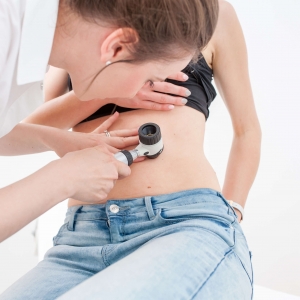
Dr. Kevin McKerrow
DERMATOLOGIST
+ SEE BIO
Melanoma of the skin is a cancerous growth that has the potential to spread (metastasize) to other parts of the body. Melanoma starts from melanocytes (cells that make melanin). In men, the most common place for melanoma to occur is on the chest or back and in women on the legs.
The ABCDE rule helps healthcare professionals assess different features to differentiate a normal mole from a melanoma:
A is for asymmetry – If one half of the mole is not the same as the other half
B is for border irregularity – If the edge of the mole is ragged or blurred
C is for colour variation – If the mole has different shades of brown, black, blue, red, white or pink
D is for diameter – If a mole has grown or is bigger than 6mm
E is for elevation – If the mole is raised above the skin and has an uneven surface
E is also for evolving – If a mole is growing, changing, itching or bleeding
Superficial spreading Melanoma: The most common type of melanoma of the skin, accounting for 70% of all melanomas. It commonly occurs on the back or chest in men and on the legs in women. It is generally slow growing at first, tending to grow outward and spread out across the surface of the skin. This type of melanoma does not usually spread to other parts of the body until it begins to grow downward. Superficial spreading melanoma varies in colour, usually with different shades of black and brown. It is usually flat and irregular in shape.
Nodular Melanoma: The second most common type of skin melanoma and grows more quickly than other types of melanoma. It is commonly found on the chest, back, head or neck and tends to grown downward (vertical growth) rather than outward (radial growth). Nodular melanoma usually starts as a raised area that is dark blueish-black or blueish-red. However, some nodular melanomas are flesh-coloured.
Lentigo Maligna Melanoma: Commonly found in older people, it occurs in areas of high sun exposure such as the face and the neck and is slow growing. Lentigo maligna melanoma is usually tan to brown in colour and varies in colour throughout. It usually appears as a large, flat abnormal skin area.
Acral Lentiginous Melanoma: A rare type of melanoma that occurs on the palms of the hands, soles of the feet or under the nails. Like nodular melanoma, it is usually aggressive and changes rapidly from radial to vertical growth. Congenital melanocytic naevi are birthmarks or large moles that are present at birth or may develop in early childhood. There may be one or more present.
Ultraviolet radiation: Exposure to ultraviolet radiation is the most important risk factor for the development of all types of skin cancer. The sun is the main source of ultraviolet radiation (UVR). Most cases of melanoma are caused by exposure to UVR from the sun.
Indoor tanning equipment: Tanning beds and sun lamps) are also a source of UVR. Having a tan means that your skin has been damaged by exposure to ultraviolet radiation.
Personal history of skin cancer: People who have already had melanoma have a higher risk of developing another primary melanoma. Having had basal cell carcinomas or squamous cell carcinomas is also linked with a higher risk of developing other skin cancers, including melanoma.
Family history of skin cancer: Your risk of developing melanoma increases if one or more of your first-degree relatives have been diagnosed with melanoma. First-degree relatives include your father, mother, brother, sister or child.
Atypical moles: An atypical mole (dysplastic naevus) is an unusual mole that looks different from an ordinary mole. Such lesions are more likely than ordinary moles to develop into melanoma. Atypical moles are most commonly found on the back, breasts, buttocks, chest and scalp and can be found on sun-exposed and non-exposed sites.
Familial Atypical Multiple Mole Melanoma (FAMMM) Syndrome: FAMMM syndrome is an inherited condition and such individuals have many moles (more than fifty), and also one or more first or second-degree relatives with melanoma. People with FAMMM have a very high risk of developing melanoma.
Weakened Immune System: People with a weakened immune system have a high risk of developing melanoma. The immune system can be weakened by certain diseases and individuals on immuno-suppressant medication following an organ transplant.
CDKN2A Gene Mutation: Around 5 – 20% of families with a high risk of melanoma have an inherited gene mutation in the CDKN2A gene. This gene is normally a suppressive gene, which means that it helps control the growth of cancer cells. Where there is a gene mutation, cancer may develop.